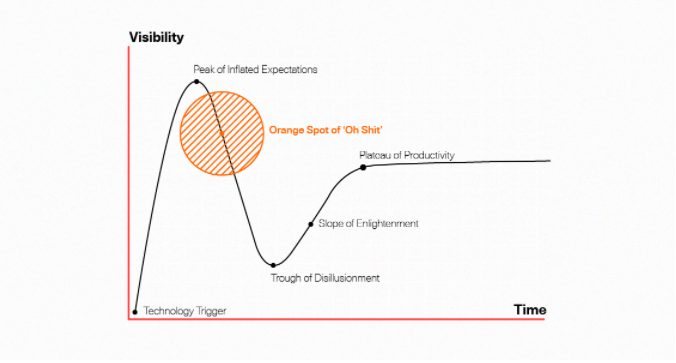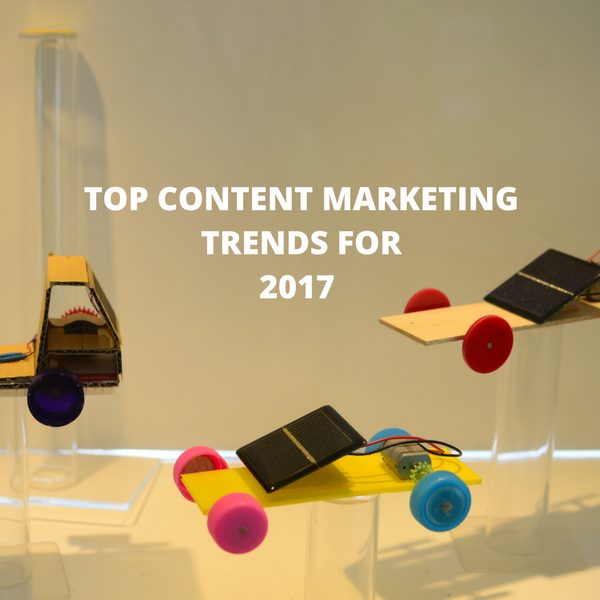Top Content Marketing Trends For 2017: Find Out What’s on the Horizon
 Content marketing continues to mature and is now used by over 85% of all marketers (B2B and B2C). But with that maturity comes the hard realization that to reach meaningful results — for example, a significant lift in site visitors, increase in conversions or in brand perception — we need to continue invest, learn, and improve.
Content marketing continues to mature and is now used by over 85% of all marketers (B2B and B2C). But with that maturity comes the hard realization that to reach meaningful results — for example, a significant lift in site visitors, increase in conversions or in brand perception — we need to continue invest, learn, and improve.
Content marketing is not a magic wand that solves all business challenges. It’s a daily struggle that requires tremendous investment. CMI’s Joe Pulizzi, referring to Gartner’s Hype Cycle, has said the industry is in the middle of “downhill slide into a trough of disillusionment.”

(Source: Doug Kessler, Velocity Partners Ltd)
By now, most brands have tried to create content. A couple of videos here, maybe a few blog posts there. For many of them, that content didn’t really move the needle. As a result, they’ve inevitably given up on their efforts.
But for the successful ones, their ability to stay on top has stemmed from an understanding that they need to address creative, cadence, and measurement in a very different way than previously.
So what are some of the main themes we’ll hear in 2017?
Chatbots are the new CRM
Six months after Facebook launched chatbots for Messenger, there are already over 33,000 chatbots on the platform. Why are chatbots so exciting? Because they offer brands the opportunity to interact with consumers in a direct and personalized way. Chatbots enable brands to create a one-on-one relationship. It’s like the future of CRM — a two way conversation rather than blast emails.
Bots can either be scripted or based on AI. Some serve a utility function (like ordering flowers or opening a support ticket) and some can provide answers using content.
In 2017 we’ll start to see many brands create sophisticated bots that engage with audiences. They’ll use a combo of their social and support teams as well as their content to enable engagements at scale.
Video Storytelling
Most online videos promoted by brands are still repurposed TV commercials. In 2017 we’ll start to see the shift towards “made for web” videos, not as commercials but rather as stories, both long and short. When creative teams are not constrained to 15-30 seconds spots or how to create a pre-roll that isn’t skipped over after five seconds, they can really focus on storytelling — providing real entertainment or educational value.
Podcasts
Just as season one of “Serial” changed the world of offline listening, transforming millions into huge fans of podcasts, “the Message” by GE is a turning point in how marketers should consider podcasts. While brands can sponsor a podcast, that’s ultimately just another form of interruptive advertising like commercials on the radio. Conversely, if you create your own podcast, as GE taught us, you can make it great.
Ebay’s “Open For Business” collaboration with Gimlet Media (the company behind podcast hits like “Startup” and “Reply All”) is another great example of how brands can evolve from interruptive push advertising to become real content marketers.
Bring Content Expertise In-House
High-quality content is vital if you are going to connect with Millennials. The challenge is how to keep the right balance between quality and quantity. Many brands now realize that the best way to create a scaled operation is to bring expertise in house. Research by Curata shows that in 2017, 51% of companies will have an executive in their organization who is directly responsible for an overall content marketing strategy (e.g., Chief Content Officer, VP of Content, or Director of Content). These people are hiring content specialists (some who may even be ex-journalists and editors). These content specialists are producing great content that aligns with the product and category, while conforming to all corporate policies and regulations.
Content Analytics and Content Attribution
With the evolution of creative skill-sets comes the realization that successful content marketing measurement requires not only a different approach, but also different tools.
Google Analytics often falls short in providing a clear map of how each channel is driving engagement with the content and how an engagement with one piece of content at the top of the funnel influences a CRM registration at the bottom of it. Moreover, it is hard to use Google Analytics to see how a blog view leads to a Facebook app download or a Google search and conversion.
That’s why more and more companies are turning to solutions like Trendemon.com to better understand and optimize their true content attribution and engagement.
Mobile
It is simply not good enough anymore to ensure that your content is responsive and looks good in mobile. The entire experience with your brand needs to be evaluated from the perspective of mobile first. If you didn’t make sure of this already, than you are way behind.
In 2017 the majority of engagement with your website will happen on a mobile device. How fast does your site load? How easy is it to navigate? How is the design optimized for a mobile vertical view and scroll mode? Do you have experiences especially made for mobile, like a one-click button to call your office, or a link to open Waze to navigate easily? Most brands’ websites are repurposed desktop experiences, and those will just not suffice.
VR/AR
VR is still niche and not mass market. But don’t ignore the hype. It’s important to start thinking about how you can create content for that world, given the expectation that this tech will become mass market in 2018.
Conclusion
If 2016 was all about realizing how hard it is to break through the noise of content, 2017 will be about experimenting with new mediums, skillsets, and measurement techniques. With so-called disillusionment also comes breakthroughs and innovations. We hope to see more of that in the year ahead.




